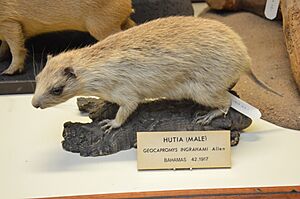Bahamian hutia facts for kids
Quick facts for kids Bahamian hutia |
|
|---|---|
 |
|
| Conservation status | |
| Scientific classification | |
| Genus: |
Geocapromys
|
| Species: |
ingrahami
|
The Bahamian hutia (Geocapromys ingrahami), also called Ingraham's hutia, is a small, furry mammal. It looks a bit like a large rat or a rabbit. This animal lives only in the Bahamas.
Bahamian hutias live in burrows in forests or bushy areas. They come out at night to find food. They eat leaves, fruit, and other plants. For a long time, people thought the Bahamian hutia was extinct, meaning it had died out completely. But it was found again in 1964! Now, people are working hard to protect it. The Bahamian hutia is part of a group of rodents called hutias. Many hutias live in the Caribbean, and sadly, many of them are in danger or have already become extinct.
Contents
What Does It Look Like?
The Bahamian hutia is a rodent with a short tail. Its body can grow up to about 60 centimeters (24 inches) long. Its fur can be many different colors, like black, brown, gray, white, or reddish.
Where Do They Live?
The Bahamian hutia is found only in the Bahamas. This means it is endemic to these islands. Its natural homes are warm, wet forests, dry bushy areas, and rocky places.
People thought the Bahamian hutia was extinct until 1966. That's when a scientist named Garrett Clough found a small group of them. He found them on East Plana Cay. This is a tiny, empty island east of Long Island in the Bahamas. The Plana Cays are the last natural home for the Bahamian hutia. Most of the remaining hutias live there today.
To help protect them, some hutias were moved to parts of the Exuma Cays Land and Sea Park in 1973. This was done to help their numbers grow. Some scientists also think they might still live in the Turks and Caicos islands.
How Do They Behave?
Bahamian hutias are nocturnal. This means they are active at night and stay underground during the day. They can climb trees, but they usually look for food on or near the ground.
They eat leaves, young plant shoots, fruit, nuts, and tree bark. Sometimes, they might even eat insects or small lizards. They have also been seen eating seaweed!
Adult hutias often stay together as a pair for a long time. They can have babies at any time of the year. After about four months, up to four young hutias are born. They can start eating solid food just a few days after birth. Young hutias might stay with their family for up to two years. By then, they are old enough to have their own babies.
Different kinds of hutias can have very different personalities. But scientist Garrett Clough described the Bahamian hutia as a "most peaceable rodent." This means they are usually very calm and gentle.
Are They in Danger?
Two types of Bahamian hutias became extinct in more recent times. The Crooked Island hutia and the Great Abaco hutia were mentioned by early European travelers. They are thought to have died out by the year 1600. This probably happened because people cleared away their land, not because they were hunted directly.
Today, the Bahamian hutia is found in only a few places. Because of this, the International Union for Conservation of Nature says it is a "vulnerable" animal. This means it is at risk of becoming extinct. Even though their population is small, it seems to be staying steady. However, they could be threatened by big storms like hurricanes. They could also be in danger if new predators, like wild cats, arrive on the islands.
See also
- Hutia
- Bahamian dry forests


